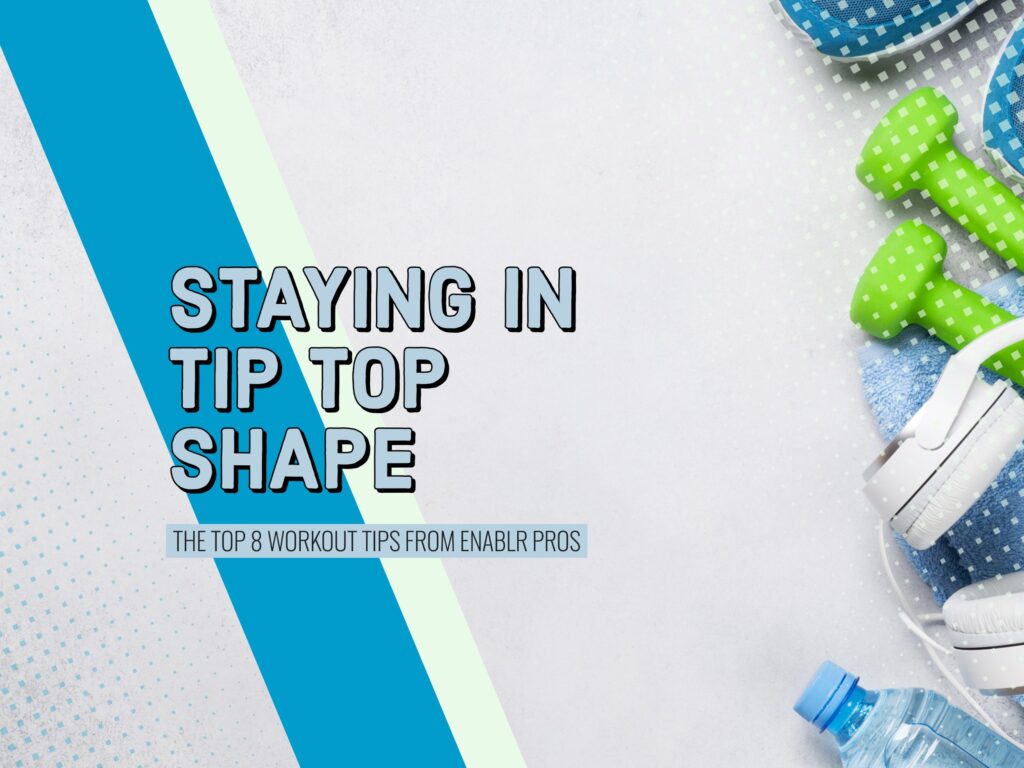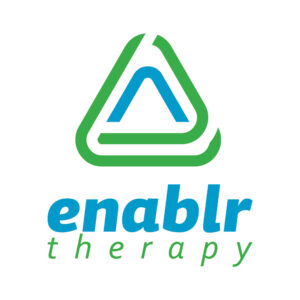
Enablr Therapy polled some of their therapy professionals to compile their top 8 workout tips. Here’s to your fitness journey!
Top 8 Workout Tips
- Drink plenty of water. Recommended daily fluid intake is 91 oz for women and 125 oz for men with about 20% coming from food. Activity level, size, metabolism, diet, and climate influence fluid needs. Drinking water aids digestion and blood flow, lubricates joints, and increases energy and brain function.
- Sleep regularly. Adults should sleep 7 or more hours per day to allow the body to reset and recover from a day’s activities.
- Eat regular/well balanced meals and after workouts. Eat within 30 minutes post workout with protein/carbs to replenish the muscles and speed recovery. Eat well balanced meals throughout the day.
- Wear proper footwear. Prevent injury with proper fitting shoes. Workout shoes should feel snug around the heel and midfoot but leave room for the toes (about a thumb’s width). Many specialty sports shoe stores can evaluate your arch height and foot mechanics to help you select shoes that fit your foot type. Running shoes should be replaced every 400-600 miles due to wear on the shock absorption.
- Know Your Limits: Knowing what you can do and can’t do is important. Don’t lift more than you can handle and don’t push yourself too hard or too quickly. Strength and flexibility training come with time. Gradually increase the weight, frequency, and number of repetitions in your program to challenge yourself.
- Focus on Form: Using proper form is crucial to avoid injury and ensures that you are working the right muscles. Proper back mechanics is essential when lifting weights, for instance.
- Cool down after working out. Stretching or taking a walk after working out helps to regulate heart rate, blood pressure, and breathing as well as promote relaxation. Taking an ice bath or cool shower post workout is a great way to reduce inflammation and the risk of Delayed Onset Muscle Soreness (DOMS) after workouts. For an ice bath, use water that is 50-60 degrees for up to 15 minutes.
- Vary workouts with hard, easy, rest days. Varying workouts assists with joint health and organ function and increases metabolism. Changing workouts also reduces overuse injuries.
Stretching Tips
When thinking about fitness, exercises such as running or lifting weights typically come to mind before stretching. However, stretching is an important part of a fitness routine as it helps to decrease your risk of injury while increasing range of motion, blood flow, and overall flexibility for movement.
Although stretching can reduce injury, it can also cause injury if not done properly. Below are a few quick tips for safe stretching from Enablr’s therapy professionals.
- Warm Up Before Stretching. Walking, swimming, low intensity jogging or biking can warm up muscles so that they stretch more. If you are sprinting or performing a speed based activity, skip the stretching until after the event. Some studies suggest that stretching can reduce speed and performance.
- Smooth, Not Bouncy. Bouncing can actually tighten muscles. Strive for gentle and smooth movements.
- Feel The Stretch, Not Pain. You should feel the muscle pull but it should not be painful. If it hurts, you are pushing too far. Back off to where the pain stops and then hold.
- Hold The Stretch, Not Your Breath. Hold a stretching position for at least 30 seconds. Ensure that you are breathing.
- Keep It Even. Everyone has a different level of flexibility. Instead of comparing yourself to others, focus on your own flexibility. Ensure that your movements are even and symmetrical on each side as more tightness on one side or the other could increase the risk of an injury. Stretch the large muscle groups in your calves, thighs, hips, lower back, neck and shoulders.
Exercising and stretching are vital for maintaining overall health. However, it is important that you are doing exercises and stretching properly so that you do not cause injury. View our physical therapy services to learn more. Here’s to your wellness journey!
References:
Ballestrini, C. (2017, August 12). Finding the Right Running Shoe. Orthopedics & Sports Medicine UConn Health. Retrieved January 20, 2022, from https://health.uconn.edu/orthopedics-sports-medicine/2017/08/12/finding-the-right-running-shoe/
Luff, C. (2021, June 17). Recovery Practices After a Hard Run. Verywell Fit. Retrieved January 20, 2022, from https://www.verywellfit.com/post-run-recovery-tips-2910938
Healthessentials. (2021, November 23). How Much Water Do You Need Daily? Cleveland Clinic. Retrieved January 20, 2022, from https://health.clevelandclinic.org/how-much-water-do-you-need-daily



